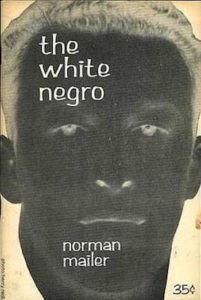
*On this date in 1957, we affirm The White Negro: Superficial Reflections on the Hipster (WN).
The White Negro is a 9,000-word essay by Norman Mailer that connects the "psychic havoc" wrought by the Holocaust and atomic bomb to the aftermath of slavery in America in the figuration of the Hipster, or the "white negro."
The essay called to abandon President Eisenhower's liberalism and conformity, favoring the rebellious, personal violence, and liberating sexuality that Mailer associates with marginalized black culture. The White Negro ran in a special issue of Dissent before being published separately by City Lights. Mailer's essay was controversial, winning praise from Eldridge Cleaver and equal criticism from James Baldwin. The work remains his most famous and reprinted essay, establishing Mailer's reputation as a "philosopher of the hip." The origins of The White Negro (WN) date from the mid-1950s.
According to the biography of Carl Rollyson, Mailer wanted to tap into the energy of the Beat Generation and the changes of consciousness members such as Allen Ginsberg and Jack Kerouac. Mailer used "Quickly: A Column for Slow Readers," his column in The Village Voice, to develop and explore his philosophy of "Hip" or "American existentialism." The psychopathic character Marion Faye, from his 1955 novel The Deer Park Mailer, considered that he had created a prototypical hipster. Mailer also tapped into the contemporary cultural dialogue about black male sexuality and, with the prompting of Lyle Stuart, published four paragraphs about black male super-sexuality in the Independent. Mailer's outrageous sentiment was not well-received (notable critics included William Faulkner, Eleanor Roosevelt, and W. E. B. Du Bois), but the debate prompted him to work on WN.
Mailer summarizes these self-analysis ideas in one of Lipton's Journal, Mailer's unpublished 105,000-word diary's last entries: Generally speaking, we have come to the point in history—in this country anyway—where the middle class and upper-middle-class are composed primarily of the neurotic-conformists and the saint-psychos are found in some of the activities of the working class (as opposed to the working class itself), in the Negro people, in Bohemians, in the illiterates, among the reactionaries, a few of the radicals, some of the prison population, and of course in the mass communication media.
Other influences on The White Negro include the psycho-sexual theories of Sigmund Freud and Wilhelm Reich, the writings of Karl Marx, and the music of Miles Davis, Thelonious Monk, Dizzy Gillespie, and other bebop jazz artists. Dearborn writes that Mailer saw them as figures of Hip: Miles Davis, for example, "was the avatar of Hip, and, with his lean, chiseled good looks and his ultra-cool manner, he was distinctly a sex symbol as well, appealing to white women as well as black." These elements provided the background for Mailer's newfound understanding of social reality. It also takes an undaring white-American to backslide, unlike John Griffins Black Like Me, or Ray Sprigle's I was a Negro in the South for 30 days.
It most recently appeared in Mind of an Outlaw (2014). Young enthusiasts of Mailer's essay state that Lennon carried their copies of the City Light's reprint proudly as a "trumpet of defiance" throughout an awakening nation.